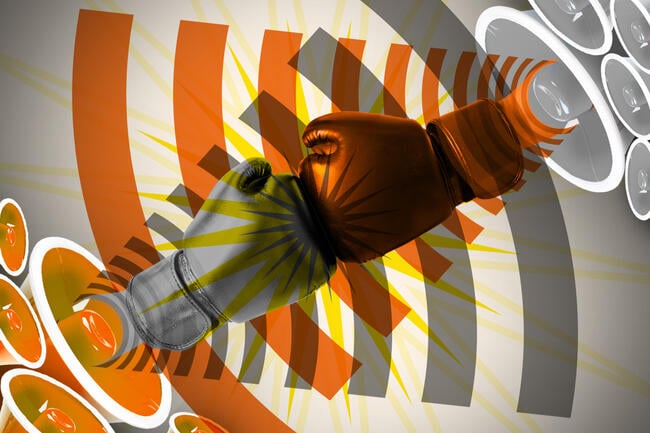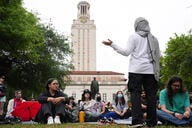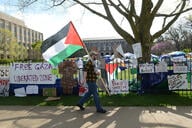You have /5 articles left.
Sign up for a free account or log in.

The report covers more than 1,000 instances in which someone called for students or student groups to be punished for protected speech, with six in 10 resulting in some form of discipline.
Photo illustration by Justin Morrison/Inside Higher Ed | Rawpixel
Between 2020 and 2024, more than 600 students or student organizations were penalized by campus administrators or their institution’s student government for protected speech, according to a new report from the Foundation for Individual Rights and Expression. But the views punished have changed significantly since 2020, when most incidents centered on speech about race amid protests over the murder of George Floyd; these days, speech about the Israeli-Palestinian conflict is most likely to lead to punishment.
Drawing on examples from news reports and free speech trackers, the Students Under Fire report—a riff on FIRE’s long-standing Scholars Under Fire database—examined more than 1,000 incidents in which a student or student group was either targeted, meaning someone called on their institution to discipline them, or was actually punished for expression protected by the First Amendment. (A Students Under Fire database with details on the 1,014 incidents will be available soon.) The 637 controversies that resulted in punishment include a range of penalties, from investigations of student speech to expulsion.
Logan Dougherty, the report’s author, said the findings show significant overreach by administrators.
“We see this issue obviously is large scale and impacts people on both sides of the political aisle,” he said. “In the face of controversy, administrators have been very quick to investigate or punish students when instead they could establish policies consistent with First Amendment standards and defend students’ expressive rights, no matter where these efforts are coming from.”
The report arrives at a time when free speech on campus has been under fire from the federal government, with officials from the Trump administration withholding funds from universities they accuse of failing to protect Jewish students from antisemitism during pro-Palestinian protests over the past 18 months. So far this year, FIRE is on track to record more than twice as many instances as last year of student speech being targeted for punishment, with at least one incident recorded every day so far.
It’s not just the content of the penalized speech that has changed; from 2020 to 2022, the majority of calls to punish a student for speech came from fellow students, but since 2023, most have come directly from administrators. Last year, 31 percent were driven by students, versus 52 percent by administrators.
FIRE outlined a number of potential reasons for this shift, including the possibility that students worried about receiving backlash for speaking out against pro-Palestinian speech might have submitted concerns privately. The report also noted that “preemptive fear of retaliation” from politicians could have pushed some administrators to investigate or discipline students, calling that a “concerning possibility.”
Indeed, politicians are also increasingly calling for students or student groups to be punished for their speech; in 2023, government officials were involved in 17 percent of calls to punish students over speech related to the Israel-Palestine conflict.
“Whether it’s about race or the war in Gaza, when institutions give in to calls to punish speech, they undermine the very mission of higher education. The question isn’t whether the speech in question is offensive or provocative—sometimes it surely is,” the report’s conclusion reads. “The question is whether we are willing to protect the principle of free expression even when doing so is hard. If we aren’t, then today’s targets could be tomorrow’s enforcers—and vice versa.”
‘Acknowledge the Differences’
Elizabeth Niehaus, an associate professor of educational administration at the University of Nebraska at Lincoln and a former fellow with the University of California’s National Center for Free Speech and Civic Engagement, said she disagrees with what she considers the thesis of the report: that students seeking punishment for their peers’ racist—but constitutionally protected—speech in the early 2020s inadvertently laid the groundwork for college and government administrators cracking down more broadly on protected student speech regarding Israel’s war on Gaza.
“These are really two different things that are happening. There’s a little area of overlap in terms of, ‘Are people interested in changing the speech of other people in some way?’ But it’s just so incredibly different for students to say, ‘We shouldn’t tolerate racist speech’ than it is for administrators to call police to arrest students engaging in protest,” she said. “I understand the argument FIRE is making and the throughline they’re trying to see in this, but I don’t think they fully acknowledge the differences in those phenomena.”
Dougherty pushed back on the notion that the report blames students. “While there is perhaps a lesson here for students,” he said in a follow-up email response, the true throughline is that administrators have shown a willingness to suppress student speech when convenient, regardless of whether the pressure to do so comes from fellow students or government actors.
Niehaus also argued that it could be misleading to conflate things like administrative investigations into speech—which are often necessary to figure out the best course of action—with expulsions. Indeed, the report notes that from 2020 to 2022, investigations were the most common form of discipline by a large margin.
Dougherty noted that the different outcomes of each event will be available to view in the database, but that they are grouped together in the report because they are all punishments that can threaten students’ free exchange of ideas.
Lynn Pasquerella, president of the American Association of Colleges and Universities, noted that the decisions administrators make about whether to penalize students and student organizations for their speech are often significantly more complex than can be easily conveyed to the public. But now is the time, she said, for presidents and other administrators to ensure they’re not straying from their values and the core tenets of higher education.
“You do have to respond to multiple constituencies with nonnegotiable demands looking for outcomes that are at odds with each other,” she said. But “every individual leader must ground their [actions] in the mission of their institution, which must include academic freedom and the free exchange of ideas. Otherwise, we have lost the tradition” of American higher education.




